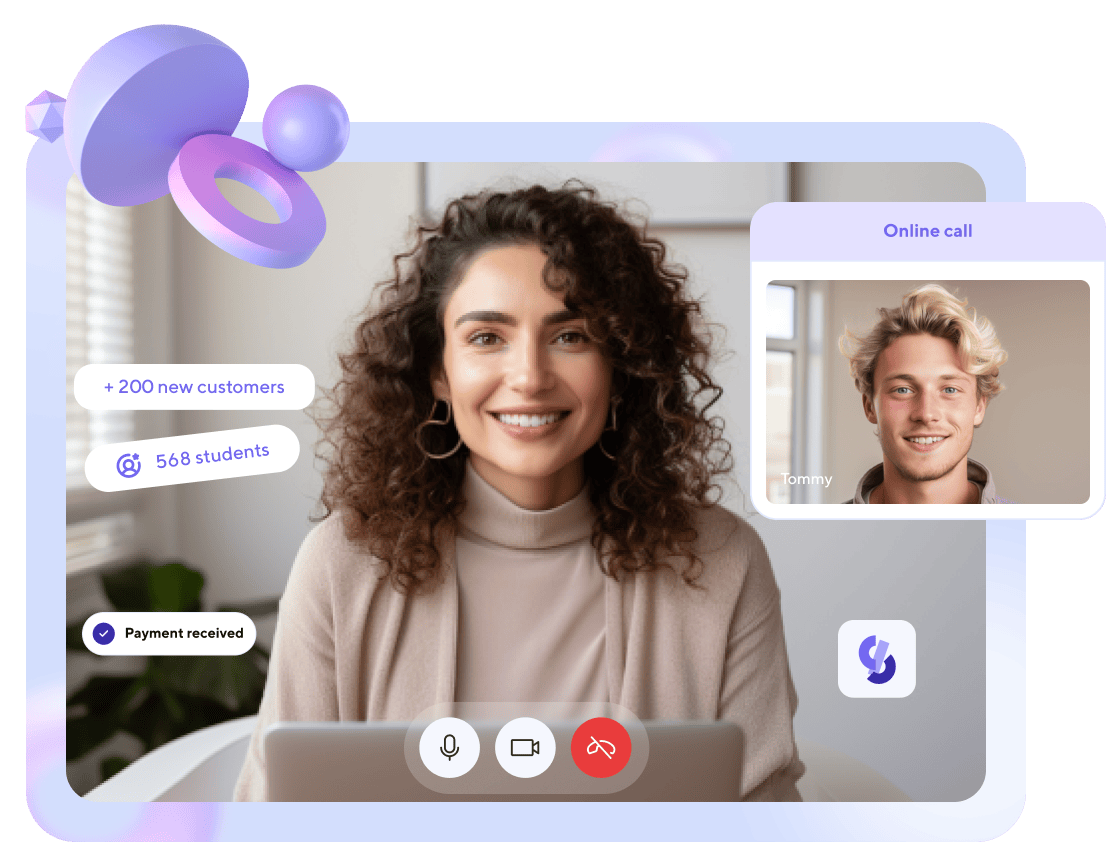How to sell courses online?
 To sell courses online, you need to fulfill three main points: study the target audience, create courses, and post them on the most convenient resource. Only then can you look for ways to sell them. This article will be useful both for those who already have a ready-made course and for those who are used to preparing in advance and want to calculate all the steps – from launching a course to promoting and selling it.
To sell courses online, you need to fulfill three main points: study the target audience, create courses, and post them on the most convenient resource. Only then can you look for ways to sell them. This article will be useful both for those who already have a ready-made course and for those who are used to preparing in advance and want to calculate all the steps – from launching a course to promoting and selling it.
How profitable is it to sell online courses?
The online education market is growing. Back in 2019, it was estimated at $144 billion. By 2022, it was estimated at $399 billion. It is predicted that by 2032, the global e-learning market will reach $1 trillion. The coronavirus pandemic has increased interest in online learning, but not every online course can make a good living for its creator. Choosing the right niche can significantly increase the chances of success. For example, courses on personal finance, fitness, marketing, professional certifications, parenting, relationships, and money are considered to be among the most profitable.
Of course, the success of any online course depends on many factors, including content quality, marketing strategy, and choosing the right audience. So, it is important to plan and research them carefully before launching the course.
Developing and preparing online courses for sale
To create online courses, you need to know your own area of expertise, as well as your target audience and what they want. At the intersection of these two points, you can find topics that will bring profit for many years.
People usually buy online courses for several reasons:
- to gain knowledge to build a career
- to improve their skills
- to get a certificate/diploma
- to learn new knowledge or skills
Before you create a course, check the interest in its topic. Gather keywords, look at current queries in the niche, ask what competitors offer, etc. If you have an audience, measure the level of interest in the topic by asking direct questions or hosting free events.
Next, adapt the course topic to the needs of the market and audience, and start developing it. If you write a description of what your clients will get after the training before creating the course, you will have a ready list of course program items. Next, choose a course format (synchronous or asynchronous), create a plan, structure and design training materials, and record lessons. Next, you need to determine the cost of the course and the model of earning money on it.
Learn more about each stage of development in our checklist “How to launch an online course in 10 steps”.
Places to sell online courses
When the course is ready, you need to decide where to place it for sale. There are three most common places to sell online courses:
- LMS
- website
- marketplace
LMS or Learning Management System is an online platform that has the functionality to create and deliver online courses. There are paid and free LMSs. The most famous free LMS are Moodle and Google Classroom. On the paid LMS market, we can name only the giants – Blackboard, Canvas, Microsoft Teams.
Free LMSs are used by general education institutions and other users who have the specialists and resources to customize the platform to their own needs. Paid LMSs have a wider range of features and help online course creators not only deliver courses but also sell them. For example, LMS Softbook tools and settings allow you to sell online courses to customers right inside the online school, as well as create landing pages and sell courses outside the school.

A website for selling courses requires a little more effort. It’s easier if you already have a website. If not, you will have to hire a designer and content manager to develop it, purchase a domain, pay for hosting, connect and set up online payment for courses. To sell online courses on your own website, you need to have a number of technical skills and have proven specialists on your team to launch and maintain it.
Marketplaces are a cross between an LMS and your own website. Over the past twenty years, the online learning market has evolved so much that it has its own marketplaces that allow you to host courses and build an expert brand. The most famous of them are Udemy or Masterclass. They allow you to post and sell online courses. However, you will have to share the profit up to 50%, as well as put up with the established rules and restrictions.
You already know about the options for hosting your online courses. Wherever they are, to sell them, you will have to choose and apply one or more ways to attract your audience. That’s what we’re going to talk about next.
Ways to sell online courses
There are dozens of ways to sell online courses. Every year, with the advent of digital technologies, new social networks, or features in familiar social networks, there are more and more of them. But we have collected the most common and proven ones:
- Website/landing page.
Online courses can be sold on your school’s specialized website or on a separate landing page. The course description on them should encourage customers to purchase the course or perform any other action you have planned. When creating a course page on your website or developing a landing page, you should consider important elements that can increase conversion:
- The banner of the course page should attract attention and inform customers about the benefits they will receive from the course. It should consist of a course title, headline, subheading, and a call to action that tells visitors what to do.
- Course description. It should give the prospective student a complete picture of what they will learn, what the program looks like, and how they will be able to use the skills they have acquired.
- information about the teacher. Add a photo and a brief description of the teacher’s specialization, area of expertise, and achievements. Clients like to see what kind of pro they will be learning from.
- social proof blocks. A list of frequently asked questions, testimonials from graduates, a money-back guarantee – all this increases the level of customer trust and encourages them to buy.
- Content marketing.
Create a blog on your website. If you don’t have a website, create one on any other platform where your target audience would be interested in reading it. Post articles and other useful materials on and around the topic of the course, and periodically add links to your course page. SEO-optimization of your content, website, or landing page will also significantly increase the chances that your course will be found and purchased.
- Social media.
To reach a larger audience, share your useful content on social media. Create profiles where your target audience is and build relationships with them. Join communities, claim your expertise, and talk about your course. You can also find partner bloggers, order ads from influencers, and customize ads according to various parameters within the social network.
- Email database.
A reliable tool for selling online courses. If you already have a database of customer email addresses, it is enough to segment it by interest and send an offer to purchase and take an online course. This can be a series of emails with special discounts, pre-registration for a course on a special offer, etc. It’s important to remember that such emails should have an attractive subject line, a time limit, and a link to the landing page/website with the course. Don’t use the following words in your email subject lines: discount, free, sale, extra income, promotion, etc. These words can cause your emails to go to spam and never be seen by the recipient. Test email subject lines and texts, use the A/B testing method to find out what your audience responds to best. Track your email open rates, click-throughs, and conversions to improve your email campaigns in the future. If you don’t already have an email database, there are many ways to collect it. For example, you can use free useful materials and tripwires.
- Free products.
They are also called lead magnets. These are gifts that you can give away to your website visitors in exchange for their email address and name. This is a small material that contains useful information for the audience: a checklist, an e-book, a template, etc. It can not only help to learn something new about the topic, but also show you as an expert who is well versed in the topic/area. Usually, it is placed in the form of an attractive banner on a website or a link in the description of a social media account. Such a free product can also be a webinar, consultation, lecture, etc.
- Tripwires.
A low-cost product designed to increase customer confidence in the seller and make them want to buy a more expensive product. Often, customers are not ready to buy a course right away. This can happen because they are not familiar with you, your online school, and your products. To “break the ice”, you can use tripwires. This is a product with a low price, but with useful and relevant information for the client – mini-courses, manuals, webinars. Anything that can show how you interact with customers and make them want to learn more about a topic that is better covered in the main product – your course.
- Sales funnel.
This is a model that describes the stages a potential customer goes through from their first contact with a product or brand to making a purchase. It helps to understand and improve the sales stage of an online course. For a sales funnel to work, you need to schedule its stages – from the moment a customer enters it (for example, by downloading a free product) to the moment they buy a course, and also provide for interaction with the customer at each stage.
An online course sales funnel can look like this:
- Prospective students come to the website through social media, advertising, search queries, or referral links.
- They study the information about the course on the landing page, which contains detailed information and benefits of learning.
- Interested parties register by entering their email, phone number, and name.
- Potential students can view free lessons or sample materials, which increases their interest in the course.
- Then they can participate in webinars or online events where they get more information and the opportunity to ask questions.
- They receive additional materials to help them make a decision, such as feedback from other students, answers to questions, consultations, and special offers.
- After detailed consideration, each client makes a decision and purchases an online course.
- The customer gets access to the course materials and becomes a student after successful payment and registration.
This funnel helps you understand how your audience interacts with your product and gives you the opportunity to optimize each stage to improve conversions.
- Advertising. A quick way to drive traffic to your website and draw attention to your online course. Paid ads aimed at specific customers can be more effective than all the methods mentioned above.
There are several types of paid advertising:
- Search ads. It shows your potential customers an ad about your course and is thematically related to the user’s search query.
- contextual advertising. Advertising placed on resources on a topic that is relevant to the product/offer being advertised.
- advertising in social networks. Advertising aimed at a specific target audience with a clear set of characteristics and interests.
- Native advertising. An advertising format that is designed to organically fit into the context and style of the platform or resource on which it is placed. The main idea of native advertising is to look like a part of the existing content, not like a typical advertisement.
- Affiliate program. A way to promote and sell online courses with the help of your own audience and fans. You can create a promo code to sell your course or a special referral link and distribute it to your friends and followers. They will advertise your course and distribute promo codes or referral links to others. You can give them a certain reward for each registration and payment. By the way, Softbook has a promo code generator.
- Free versions/beta testers. Make the 1st lesson of your course free so that everyone can sign up and see how everything works. It should be planned in such a way that potential customers will want to continue learning. You can also announce to your audience that you’re looking for beta testers to test the new course. Give the course to a few clients to take and report back on their experiences. This way, you’ll get feedback and suggestions on how to improve the course, as well as a group of loyal customers who can sincerely and actively invite others to take the course.
- Participation in industry events, broadcasts, and guest posts. Participate in all possible industry events, introduce yourself as an online course author, school owner, etc., talk about the course development, its benefits, and availability for purchase. Give bonuses to your audience in the form of discounts or small additional training materials. Agree to lectures, podcasts, discussions, or broadcasts with fellow experts, look for opportunities to meet colleagues and agree on cooperation. Try to be visible and actively participate in the life of the field, maintain connections with communities – all this will help you sell online courses directly or indirectly.
This is an exhaustive but sufficient list of ways and tools to sell online courses. You don’t have to try them all at once. We recommend choosing the most interesting ones and testing them in practice.
Articles are good, but social media posts are faster!
Subscribe to us and be the first to receive tips and tricks
on promoting your online school!


Earn money on your knowledge and experience with
Softbook!
to the platform for setting up your own school!





